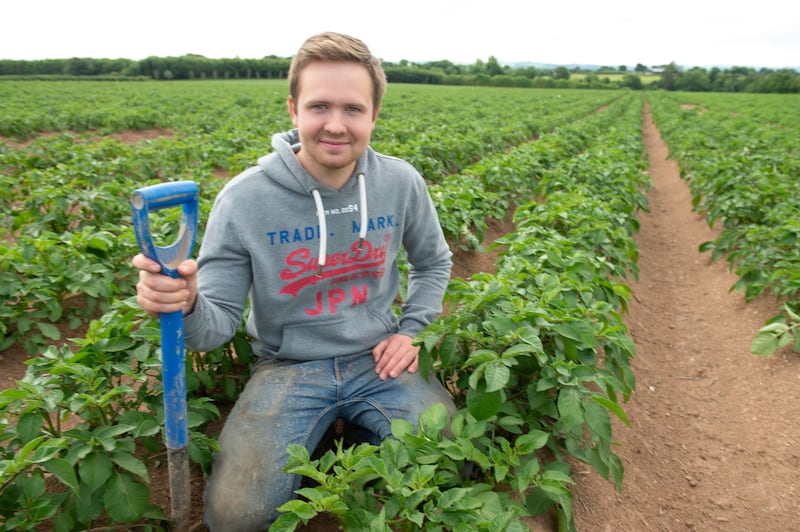“I’ve never seen anything like it in 35 years, I’ve never seen such a shortage,” says Dan Horan, owner of Horan’s Fruit and Veg in Tralee and Killarney, Co Kerry.
With previous potato shortages, suppliers would hold back some potatoes and sell them when scarce, but this year is different, “they’re completely finished up”, he says.
Floods followed by frost in October meant many popular late varieties such as Roosters and Kerr’s Pink were lost across the country while prolonged wet weather this spring has caused widespread delays in getting potatoes in the ground, something also happening across Europe.
Last year’s growing season was described by the Irish Farmers’ Association (IFA) as “the worst in living memory” due to similar conditions, while the current shortage that is affecting all varieties grown in Ireland is expected to worsen until mid-July.
“Spuds are about two months short this year, normally Kerr’s Pink and [Golden] Wonders go on until July 1st, but this year, they finished around May 1st,” says Horan.
Although there are Rooster potatoes available in his stores, their popularity is not as great in Kerry as elsewhere, with Kerr’s Pink accounting for about 90 per cent of his potato sales.
“They’ve (roosters) never been popular for us at all. There’s no point in telling people who drink Guinness about Heineken and it’s the same with people who eat Kerr’s Pink, you can tell them about Roosters or anything else but they don’t want to know,” he says.
That’s why I did the video on TikTok, explaining the difficulty we have and asking them to bear with us
— Dan Horan - Horan’s Fruit and Veg
Shops across the country which rely on local suppliers have had to change tactics, with some promoting alternative, lesser-known varieties in the hope customers will hang on until more coveted varieties come on stream.
Until Kerr’s Pink potatoes come back in stock, Horan has tried to encourage customers to try other varieties to fill the gap through a video on TikTok, which has since gathered almost 150,000 views.
“That’s why I did the video on TikTok, explaining the difficulty we have and asking them to bear with us,” he says adding: “We hope we will get back to normal in August, but we’ve found it very difficult this year.
“This is the worst year for me in 35 years and with where the climate has gone, I hope it isn’t a signal for the future,” he adds.
Demand outstripping supply will result in rationing by way of smaller packaging in shops, higher costs, and lower quality imports from abroad until harvesting picks up in mid-July, impacted growers have said.
“This year, we were actually questioning if we’d get them into the ground at all, we’ve never been in that situation before,” says Colin Buttimer, a potato grower in Fermoy, Co Cork.
The 24-year-old sits on the IFA’s national potato committee, which represents the country’s 600 commercial potato growers, and was among the last growers to finish planting at the start of June.
His father, who has been growing potatoes for over 40 years had never planted in June until this year.
“There’s always been wet years and dry years but at the same time, the way the weather is going, it’s a bit frightening,” he says.

Ideally, planting would have been complete in April, and while May would be considered late, June had been unheard of at Rockvale Farm in Fermoy until now.
Regardless of getting them into the ground, Buttimer says the damage is already done, in a way, as the late planting will result in lower yields and subsequently, lower earnings.
“It’s making the job a lot more difficult, a lot less enjoyable but at the same time, it’s in the farmer’s nature to keep working away, it’s completely out of our control,” he said.
Buttimer suggests new varieties with shorter growing seasons could mitigate the risks of weather extremes in future, something researchers at Teagasc and IPM Potato Group are constantly working on.
The farming agency releases two or three new varieties each year, but it seems nothing can live up to the ever-popular Rooster, outside of Kerry at least.
Though they may not always land at home, these new varieties do well abroad, with over 50 countries purchasing them each year.
“New varieties are very much on our mind,” says Denis Griffin, potato breeder and principal research officer at Teagasc.
[ Wet weather: major potato shortage looms due to persistent rainfallOpens in new window ]
However, developing and breeding the next big super potato which is less affected by prolonged wet weather is no simple task, especially when it must be acceptable to the consumer.
“We need varieties that are earlier in general but we also need varieties that are more fertiliser-use efficient but those varieties tend to be later maturing,” he says.
Each variety will have a different problem each year, be it dry conditions, wet conditions or late blight, which is becoming an “increasing problem”, particularly in the context of blight resistance to common chemicals used to control it.
“While we can breed varieties with resistances, they have to appeal to the customer. It’s more difficult than breeding other varieties, you’ve got to have something that’s sustainable and profitable for the farmer to grow,” he said.
It may be possible in the future to take a late variety such as the Rooster and use gene editing techniques to make it slightly earlier, he added.
However, this would not solve the issues posed by prolonged droughts that also result in lower yields, like those seen in 2018, in which later varieties fared much better than their earlier counterparts.
- Sign up for push alerts and have the best news, analysis and comment delivered directly to your phone
- Join The Irish Times on WhatsApp and stay up to date
- Listen to our Inside Politics podcast for the best political chat and analysis


















